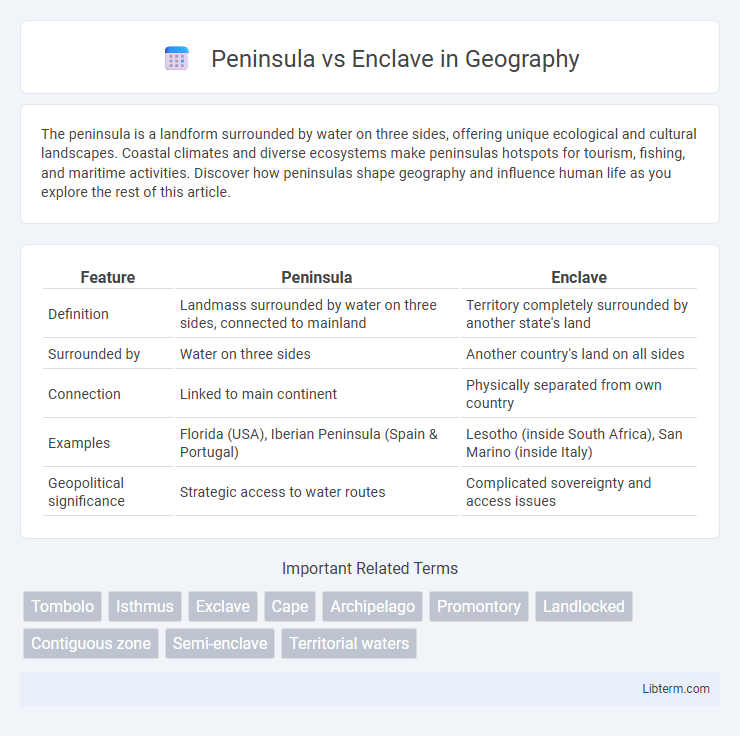The peninsula is a landform surrounded by water on three sides, offering unique ecological and cultural landscapes. Coastal climates and diverse ecosystems make peninsulas hotspots for tourism, fishing, and maritime activities. Discover how peninsulas shape geography and influence human life as you explore the rest of this article.
Table of Comparison
| Feature | Peninsula | Enclave |
|---|---|---|
| Definition | Landmass surrounded by water on three sides, connected to mainland | Territory completely surrounded by another state's land |
| Surrounded by | Water on three sides | Another country's land on all sides |
| Connection | Linked to main continent | Physically separated from own country |
| Examples | Florida (USA), Iberian Peninsula (Spain & Portugal) | Lesotho (inside South Africa), San Marino (inside Italy) |
| Geopolitical significance | Strategic access to water routes | Complicated sovereignty and access issues |
Defining Peninsula and Enclave
A peninsula is a landform surrounded by water on three sides, extending from a larger landmass, often characterized by its connection to the mainland through an isthmus. An enclave is a distinct territory or cultural group entirely enclosed within the boundaries of another territory, frequently defined by political or ethnic distinctions rather than geographical features. While peninsulas are natural geographic formations, enclaves are primarily political or administrative regions embedded within a different governing area.
Key Geographic Differences
A peninsula is a landform surrounded by water on three sides, extending from the mainland, which creates distinct coastal boundaries. An enclave is a territory completely enclosed within the boundaries of another territory, often without direct access to open water. The key geographic difference lies in a peninsula's partial water border versus an enclave's complete land enclosure.
Formation and Origins
A peninsula forms through geological processes such as tectonic plate movements, sediment deposition, and erosion, extending land into a body of water. An enclave originates from political, cultural, or historical circumstances, often representing a territory entirely surrounded by a different state or region. Peninsulas are natural landforms shaped by environmental forces, while enclaves result from human-defined boundaries and geopolitical divisions.
Notable Examples Worldwide
The Korean Peninsula, spanning approximately 1,100 kilometers, is a prominent example of a peninsula separated from mainland Asia by the Yellow Sea and the Sea of Japan, hosting North and South Korea. Gibraltar represents a notable enclave located on the southern coast of Spain, politically part of the United Kingdom but surrounded by Spanish territory. Another significant enclave example is Lesotho, an independent nation entirely surrounded by South Africa, demonstrating the geopolitical uniqueness of enclaves globally.
Strategic Importance
A peninsula offers significant strategic military advantages due to its access to surrounding waters on three sides, enabling effective naval defense and control of maritime routes, which is crucial for trade and military logistics. Enclaves, being territorially isolated within another state, hold strategic importance as they serve as critical footholds for influence, intelligence gathering, and diplomatic leverage despite their vulnerability to siege or supply challenges. Control over a peninsula typically ensures sustained power projection and resource accessibility, whereas enclaves often represent geopolitical bargaining chips in broader regional conflicts.
Cultural and Political Implications
Peninsulas often facilitate cultural exchange and political integration due to their accessibility and connection to larger landmasses, promoting shared identities and cooperative governance. Enclaves, isolated within foreign territories, tend to preserve distinct cultural practices and face unique political challenges, including limited sovereignty and diplomatic complexities. The contrasting geographical contexts of peninsulas and enclaves fundamentally shape their social cohesion and international relations.
Economic Impact and Resources
A peninsula often benefits from diverse economic activities such as fishing, tourism, and maritime trade due to its extended coastline and access to multiple water bodies, enhancing resource availability and economic growth. Enclaves, typically landlocked and surrounded by foreign territory, face limited access to natural resources and markets, often resulting in higher dependency on neighboring states for trade and economic development. The economic impact of a peninsula tends to be more positive with natural resource exploitation, whereas enclaves encounter challenges in resource management and economic self-sufficiency.
Accessibility and Transportation
A peninsula is a landform surrounded by water on three sides, typically connected to the mainland by a narrow strip of land, allowing relatively straightforward accessibility and transportation via roads or bridges. In contrast, an enclave is a territory completely enclosed within another territory, often requiring passage through the surrounding area to access it, which can complicate transportation and limit direct routes. Transportation infrastructure for peninsulas usually includes coastal roads and ferries, whereas enclaves depend heavily on agreements with the surrounding territory for transit rights and border controls.
Environmental Considerations
Peninsulas and enclaves differ significantly in their environmental contexts, with peninsulas often featuring unique coastal ecosystems due to their extensive water boundaries, supporting diverse marine and terrestrial habitats. Enclaves, typically landlocked and surrounded by another territory, face distinct ecological challenges such as limited access to natural resources and restricted environmental management options. Understanding these spatial and jurisdictional differences is crucial for effective environmental planning and conservation strategies tailored to each landform's specific ecological conditions.
Comparative Analysis and Conclusion
A peninsula is a landform surrounded by water on three sides, connected to the mainland by a narrow strip of land, whereas an enclave is a territory entirely enclosed within another political entity. Geographically, peninsulas influence climate and transportation due to their extensive coastlines, while enclaves present unique political and administrative challenges related to sovereignty and access. Peninsulas primarily impact natural landscapes, but enclaves affect geopolitical boundaries, making their distinctions crucial for understanding regional geography and international relations.
Peninsula Infographic

 libterm.com
libterm.com